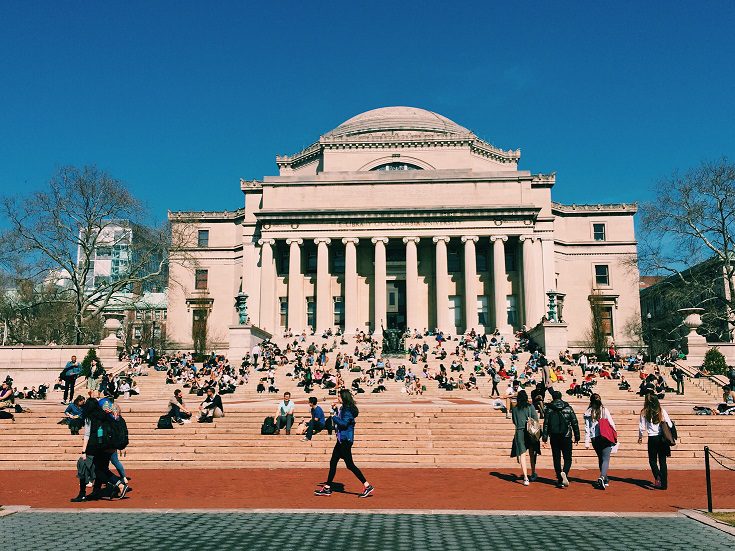Study in the USA
Study in the USA – great universities; great choice
Depending on where or what you choose to study in the USA, the country has a huge range of great universities with amazing facilities. The USA is the most popular study destination for international students, with over a million currently working towards their degrees across six time zones ranging from the beauty of Hawaii to the Pacific coast, and ultimately across to the shores of the Atlantic. Because the country is so large and incredibly diverse, it offers a great variety of experiences and ecosystems. Do you want to study in New York or California, Chicago or Colorado?
Why not join them!
You are spoilt for choice but fortunately, Elab’s experienced USA team of consultants can help you make that choice.


Study in the USA - most frequently asked questions


Where you can apply with Elab to study in the USA?
Elab has placed students in the following top US universities:
- Harvard
- University of California Berkeley
- University of Pennsylvania
- New York University (NYU)
- NYU Shanghai
- University of Chicago
- University of East Carolina
- University of California L.A.
- Johns Hopkins University
- Boston University
- Fordham University
- The North Carolina Chapel Hill
- University of Notre Dame
- Parsons School of Design
If you intend to study in the USA, we are your go-to agency, so get in touch.
Study in the USA – why study in the USA
If you are debating why to study in the USA, a cursory glance at the world university rankings immediately reveals that USA universities are leaders in every category. USA universities dominate the lists of the world’s top educational institutions.
The mere words Ivy League, or Harvard, Yale and Princeton, for example, instantly conjure up images of academic excellence and provide students with an undeniable advantage when it comes to building a career path and making their mark in the world.


Study in the USA - courses
When you apply to study in the USA, you are not required to have decided what course or area you will specialise in.
Your first year will be an exploratory one, which is one big reason for choosing to study in the USA. For example, you might decide to take courses in Greek mythology and physics, along with Italian, archaeology and political science.
Certain universities offer students a Common Curriculum, with plenty of options within each broad category, while others essentially allow you to create your own course – timetables permitting.
It is only during your second year that you finally commit to an academic path, and choose your major subject and your minor. US study programmes offer flexible combinations, which might appear strange to European eyes, since they often span totally unrelated fields.
However, in this process you will have experienced the courses and the professors and have a far better idea of what you are ultimately interested in than when you were completing your original applications.
In short, studying in the USA is really flexible and exciting and allows you to broaden your general knowledge and understanding of the world before you choose your degree courses and specializations. If you want to get a clearer picture of what the Common Curriculum looks like, read our blog on the University of Chicago which has one of the best introductory programs in the country.
Study in the USA - how long are courses in the USA?
Studying in the USA offers two types of undergraduate degrees in the USA.
- Associate degrees run for two years and are often taken at a community, junior or technical college. Students can then transfer onto a bachelor’s course, often at a reasonably ranked university associated with the college and do another two years to get their bachelor’s degree.
- Bachelor degrees at a USA university take four years to complete, and are made up of 120-128 semester credit hours.
Master’s degrees in the USA last from two-three years and can be broadly divided into professional programs and academic programs, although there are several one-year fast-track programs.
For those more academically minded students, PhDs take four to six years.


Study in the USA - undergraduate courses
Most popular courses in the USA
The most popular courses for international students studying in the USA are:
- Engineering
- Business Administration
- Pharmacy
- Computer science and IT
- Business Analytics and Data Science
- International Business
- Physical and Life sciences
- Mathematics
- Social Sciences
Study in the USA - master’s courses
The majority of Master’s courses you can study in the USA take two or more years and lead to gaining an MA, MSc, or a speciality degree.
There are also a number of courses which take one year to complete, for example:
- Masters in Business Administration (MBA);Masters in Education (M.Ed.);
- Masters of Science (MSc);
- One Year Master of Engineering (M.Eng);
- One Year Master of Arts (MA).
You can study for a Master’s at over 1800 universities, which offer two types of graduate degree:
- Academic/research degrees
- Professional degrees – which prepare students for particular professions.
Unlike many countries in Europe, when you study in the USA, you will not find pure research programs, since all Master’s are based on a combination of research and teaching.
If you intend to study for a Master’s in the USA, contact Elab for further information and guidance.


Study Business in the USA
| UNIVERSITY | APPROXIMATE COST: TUITION FEES (excluding scholarships) |
| University of Pennsylvania | $55,584 |
| MIT | $51,832 |
| University of California-Berkley | $43,232 |
| University of Michigan | $49,350 |
| NYU | $51,828 |
| Carnegie Mellon | $55,464 |
| University of Texas at Austin | $37,480 |
| University of North Carolina at Chapel Hill | $35,169 |
| University of Virginia | $48,891 |
| Cornell University | $55,188 |
| University of Indiana – Bloomington | $35,456 |
| University of Southern California | $56,225 |
Study law in the USA
Studying law in the USA and Canada
Studying to be a lawyer in the USA requires students to complete a bachelor’s degree first, then carry on studying law at postgraduate level and do a JD (Juris Doctor) course, or an LLM.
Studying can be expensive in the USA and admission to law school is highly competitive.
This is, of course, because 50 of the world’s highest rated law schools are based in North America. Do not assume that once you have gained your degree you will be able to automatically practise law in either country.
Each Canadian province and US state has its own regulations for admitting postgraduates to the bar and you will also have to sit bar exams in order to get a license to practise.
Typically, US states only allow you to practise in the state where you studied.
Study law in the US and Canada
Admission requirements to study law in the USA and Canada:
- Undergraduate degree
- High TOEFL Exam score
- Proof of funds
- Good result in the LSAT exam
If you have set your heart on studying law in the US or Canada, the best way forward is to choose a European university which works with an American law school, so that you can get an LLB and JD in five years.
There are options to complete undergraduate studies in your home country first, then transfer for post grad studies in the USA.
You should budget from 20,000 to 40,000 euros a year for tuition fees in the USA.
Contact Elab for further information, guidance and suggestions.
Study in the USA - medicine
There are 172 medical schools in the USA – 50 of which accept international students – but they only offer postgraduate courses.
So if you wish to study medicine in the USA, firstly you will need to complete a four-year first degree – preferably in biology, chemistry, organic chemistry or neuroscience, or a similar field.
Your GPA is also important in securing a place, and should be in the 3.67 to 3.83 range, depending on whether it is a Science or Non-Science GPA.
A good MCAT score is essential, so make sure you register and practise for the exam, starting a year in advance. The 2022 student intake averaged 511.9 in their MCATs.
There are a limited number of places for international students to study at US medical schools and current admission rates vary wildly, from Stanford’s acceptance rate of 1.4 per cent, to the University of Tennessee’s 9.1 per cent, with average medical school acceptance rates of 5.6 per cent.
If you are successful and get a place, you can apply for a medical school scholarship, but these are limited and highly competitive.
Tuition fees for US medical schools are high, and a four-year course will cost $40,000-60,000 a year. Of course, in the long-term, qualifying as a doctor in the USA will more than repay the investment you have made in your future career and personal growth.
The Top 10 medical schools in the USA:


Study in USA - universities
Study in the USA – the best universities int the USA
When deciding where to study in the USA, everyone has a different view of what makes their shortlist of “best university”.
Many people base their ideas purely on rankings, others look at the location of the campus, the history, its alumni, or sports facilities. Others look at specializations to see if their research interests are properly catered for, or consider the university origins, beliefs, traditions and student societies.
Since the USA is so huge and diverse, with over 5000 universities and colleges to choose from, its climate also varies significantly. Arizona, Texas, Florida, California, and Nevada offer year-round warmth, while North Dakota, Maine, and Minnesota will have you reaching for your thermals in the late autumn.
When deciding to study in the USA, you will need to draw up a list of personal preferences and your own non-negotiables. Perhaps you have family and friends in New York, and Stanford and Berkeley are just too far away, so you might decide to apply to Columbia or Johns Hopkins University?
Similarly, you may want to live on a small campus in a rural area rather than a big city. Or go to a liberal arts college, rather than a research university.
When you study in the USA, you will easily find the university of your dreams – and Elab will help you.
Study in the USA - the Ivy League
The Ivy League, otherwise known as the Ancient Eight, is a group of eight outstanding private research universities, renowned for their world-class lecturers, excellent research facilities and high standards.
Only the best of the best are offered a place in the Ivy League, but you still have a chance. If you are accepted, the experience will be life changing.
Many Ivy League universities offer generous bursaries, so if you are gifted and apply to the right university then studying in the USA might not be too costly. However, bear in mind that in the longer term the career and associated financial benefits of getting into an Ivy League or top ranked US university can be immense, as compared to choosing a lower ranked US university or studying locally. Since you can apply to numerous US universities, it is recommended students aim high but also apply to a few “bankers” in case final exams don’t go as planned, for whatever reason, or places are limited.


Ivy League Universities – what are the key differences?
Many students from all over the world dream of studying at an Ivy League university in the USA. It is important to differentiate between these eight prestigious universities, since they have different student numbers, acceptance rates , specializations, or emphasis on sports and traditions.
Harvard, for example, is described as passionate and diverse, with exceptionally committed lecturers and vibrant social life. It is particularly renowned for its courses on Economics, Computer Science, Anthropology, Sociology, History and Political Science. However Harvard only accepts five per cent of applicants.
Yale, its historical rival, offers a sense of community in a beautiful campus setting, and delivers excellent courses in Politics and Government, Psychology and Economics, accepting a slightly higher seven per cent of applicants.
At the other end of the scale, Cornell has an acceptance rate of 13 per cent, and specialises in IT, business, agriculture, architecture and engineering, while UPenn accepts nine per cent of applicants and specialises in finance and accounting.
To get a fuller idea of each of these outstanding universities, their fees, scholarships, application processes, etc you can read full blogs on individual universities :Cornell,Harvard,Yale,Princeton,Columbia and Brown.
Study in the USA - Excellent Non-Ivy League Universities
- Massachusetts Institute of Technology (MIT)
- Stanford University
- University of Chicago
- California Institute of Technology
- Johns Hopkins University
- Carnegie Mellon
- Duke University
- Northwestern University
- Fordham University
- University of California, Santa Barbara
- Williams College
- UC Berkeley
- NYU
As you can see, when deciding where to study in the USA, you are faced with literally hundreds of options.
Non-Ivy League universities feature prominently in the QS World University rankings, which are currently headed by MIT and Stanford, with Caltech placing 4th, and the University of Chicago coming in 5th.
American universities are exceptional, and when you start to study in the USA, you will have access to cutting edge resources, brilliant lecturers and a supportive, student-centred educational environment on a lively campus.
Study in the USA - liberal arts colleges
Liberal arts colleges in the USA tend to be smaller and only offer undergraduate degrees. They provide students with a wide ranging general education in liberal arts and sciences, small classes and close contact with the academic staff. They often try out highly experimental approaches to education with great success. The vast majority of liberal arts colleges are residential, so students have a fully immersive academic experience.
Amherst College, Wellesley College, Swarthmore College, and Williams College are among the highest ranked liberal arts colleges in the USA. The majority of these colleges are private and while they do offer some scholarships, these tend to be limited in number and highly competitive.
Study in the USA - requirements
Studying in the USA requires international students to demonstrate not only their academic achievements and knowledge of English, but often also extra-curricular activities. At Master’s level, applicants may also be required to provide details of their work experience in a related field, submit references, a CV, and any research they have undertaken.
The most commonly required documents for a US application are:
Study in the USA Requirements - English language proficiency
Which English language examination do I need to pass when applying to study in the USA?
Foreign Students intending to study in the USA will need to prove their proficiency in the English language by passing a recognised English exam. The best choice for the USA is without a doubt the TOEFL test – although a number of US universities will accept IELTS. Universities will specify pass marks required.


Study in the USA Requirements - SAT and ACT tests
SAT Test and ACT Test were the norm for academic applications. The recent pandemic has significantly changed American universities’ attitudes to standardised testing, and has seen major educational institutions move away from SAT and ACT requirements altogether, or make them optional. The traditional SAT subject tests and optional essay were both discontinued in 2021.
Over 1200 universities and colleges in the USA no longer require applicants to submit their SAT and ACT tests as part of the application process – and this is a growing trend. It is also important to differentiate between Test Optional, Test Flexible and Test Blind universities.
Test Optional Universities | Test Flexible Universities | Test Blind Universities |
These universities focus on applicants’ high school records, and their academic and extracurricular achievements. They have a holistic approach to candidates and give them the option to submit their SAT and ACT scores – or not. Personal essays, a personal statement and the interview are of major importance. | Test-flexible universities allow applicants to choose which test scores they wish to submit in their application: for example, the IB diploma, the SAT reasoning paper, or three exams of their choice. | No test scores are required. |
Examples: Bowdoin, Wesleyan University, Chicago University, Bryn Mawr, Worcester Polytechnic Institute, Boston, the George Washington University, Sarah Lawrence. | NYU, Rochester University, Brandeis, Clark University, Bates College, Mount Holyoke College. | Hampshire College. |
- NB: Certain universities provide merit aid awards, and they are frequently linked to SAT scores. Not submitting SAT and ACT scores could put you at a disadvantage when applying for these grants.
- Test flexible universities increasingly ask candidates to provide supplementary material, such as portfolios, samples of writing, and details of experiments during the application process.
- The major you wish to study may well demand a SAT score. For example, the University of Iowa is test-optional, but its nursing program expects applicants to have a SAT score of 1300 and above.
- You are well-advised to check the university of your choice’s SAT and other requirements very carefully, particularly if you intend to apply for a scholarship.
What SAT result do I need to get, in order to be accepted to study in the USA?
At present SAT examination marks range from 400-1600. Ivy League universities expect applicants to get 1550 marks in the SAT, but many other universities will consider candidates who have scored in the region of 1100 marks. Bear in mind that the SAT is not the only criterion which will determine whether your application will be accepted.
When do the SAT examinations take place?
SAT exams are run quite frequently during the year. Your SAT results have to be attached to your application form, which needs to be submitted by the 15 December deadline. It takes approximately a month to receive the SAT results, so keep this in mind when you are deciding when to sit the test.
For a detailed breakdown of the SAT and ACT exams, visit pages:
– SAT
– ACT
Study in the USA - which universities in the USA accept lower SAT scores?
If you want to study in the USA, but you are worried about your SAT scores then the following tables give some indication of where you could apply based on recent data. Some of these universities may not be requesting SAT scores either temporarily because of the pandemic, or permanently. Websites are updated regularly and need to be checked closer to application times, to confirm current practice and requirements.
SAT SCORE OF 830-1030 SAT SCORE OF 1030-1200
San Diego State University | University of Texas – Austin |
Temple University | University of Florida |
University of Alabama | University of Washington |
Michigan State University | Syracuse University |
University of New Hampshire | University of Georgia |
University of Oregon | Ohio State University |
Colorado State University | Penn State |
Arizona State University | Purdue University |
| Rutgers University |
| University of Mass.Amherst |
| Texas A&M University |
| Virginia Tech |
SAT SCORE OF 1200-1340
University of S. California |
Emory University |
Tulane College |
North Carolina-Chapel Hill |
University of Mich. – Ann Arbor |
Northeastern University |
Boston University |
University of Virginia |
Boston College |
NYU |
University of Miami |
University of Wisconsin |
Study in the USA - how can I get into a university in the USA?
In order to get a place at a university in the USA you will need to satisfy its requirements, sit any tests or entry exams, and ensure you can prove English language proficiency.
Below is an outline of the application process. Remember that you will need to get a student visa once you have been offered a place, and that this can take a little time to organise, so it is never too early to start preparing your documents.
Study in the USA - applications
The process of applying to study in the USA is complex and made up of a series of steps and stages. Applications are done through the US Common App platform, or directly to universities. You must apply to study in the USA in good time , since the deadline for submitting your application is December of the year before you intend to begin your studies.
What you need to submit when applying to study in the USA:
- SAT /ACT
- Essay –in the USA, admissions departments are interested in candidates’ personalities, and application essays often ask you describe what passions you have in life, what you have achieved and where you find inspiration. Some academic institutions provide you with a topic, but you can just as easily be asked to write on a theme from a list which has been given to you in advance.
- References –two references from former teachers of the subject you intend to study.
- TOEFL
- A school report from the headmaster or headmistress which includes information about the school’s standing and reputation, the number of students and the courses it offers.
- Reports from your school – normally sending annual reports will suffice.
- Midyear report – if this does not exist in your country, you need to send a document which confirms your anticipated secondary school leaving diploma results.
- Your secondary school certificate.
- Confirmation that you have completed Middle School, i.e. school leaving certificate.
- Every applicant must have a nominated counsellor who oversees and checks that all documents have been completed, translated correctly etc.
- Each academic institution may have its own requirements, for example additional essays.
Choosing universities using the Common App provides the benefit of using one platform which processes all your applications. You need to upload your documents once, irrespective of the number of applications you wish to make. However depending on your university shortlist, you may still need to apply directly to some universities. In addition, the State of California has its own application system which candidates must use, if they wish to study at a Californian university.
Many higher-ranked universities have their own supplements embedded within the Common App, which you will also have to complete. These can take the form of short essays or questions about your interests, experiences, worldview and extracurricular activities. Check the blogs on individual universities for a full breakdown of their supplements, the most common essay titles, and other useful tips.
Study in the USA - application Interviews
Higher ranked universities may require an interview. You will probably start being invited to interviews once all the academic results are published, so expect to hear from your universities between February and April. Interview preparation is recommended. Interviews can be held at long-distance as well as face to face, depending on where the applicant is living.
Study in the USA - when to apply
It is possible to submit application papers to study in the USA at three different points in time: regular decision, early action and early decision.
What does this mean and how do they differ?
- Regular Decision:
- applications have to be submitted by the end of December , and responses are sent out by April.
- Early Action:
- Fewer people apply at this time
- Applications are submitted in October/November
- You may apply to several academic institutions
- You will receive one of three responses: rejected, accepted or moved to the regular decision process.
- You will receive your answer by 15 December, which gives you the time to apply through Regular Decision if you are rejected.
- If your application is accepted, you do not have to take the place you have been offered. You may reject it and apply against through Regular Decision.
- Early Decision:
- This is very similar to the Regular Decision process, with two exceptions – you may only apply to one academic institution and, if you are offered a place, you have to take it, as long as you have the financial means to do so.
It is important that you decide which application route you want to take before beginning the application process. Since the process demands a great deal of supporting paperwork, you would be well advised to start getting organised as early as possible.


Study in the USA - costs
Tuition fees to study in the USA
Tuition fees in the USA range from 15,000-60,000 US$ per year, however there are many generous scholarships available as well as need-based financial assistance.
On top of the tuition fees, you will have to add in the cost of travel, accommodation, living expenses, the visa fee all of which comes to approximately 1,000 euros a month.
If you are studying for a Master’s degree, you may well find work as a teaching or research assistant, and undergraduates often take campus-based part-time jobs, organised by their student union.
Study in the USA – can I study for free in the USA?
Universities in the USA are not as cheap as their European counterparts, and tuition fees are fairly high, but it is nevertheless possible for international students to cover a significant portion of their expenses by applying for scholarships or grants and taking part-time work.
Study in the USA -scholarships
The Fulbright Commission estimates that there are over 600 higher education institutions where you can study in the USA which offer scholarships worth $20,000 upwards. For example, the Fulbright Program awards full scholarships to international students who wish to do a Master’s or a PhD, which cover tuition, airfare, textbooks, living expenses and healthcare insurance.
Whilst international students cannot apply for any US government loans to finance their studies, there are many scholarships available. Competition for these scholarships is naturally extremely fierce. Some US scholarships are only open to students from a specific country. US sports scholarships are available to students who excel in a particular field. Overall, there are more grants and scholarships available to postgraduates than undergraduates.
Need-blind and need-aware universities
Individual universities offer different levels and types of scholarships and bursaries. In general, admissions committees will have a good idea of your financial status and ability to pay tuition fees, since they are “need-aware”. There has been a great deal of debate on whether this influences who is offered a place.
Five of the top 650 colleges and universities listed by Forbes – Princeton, Yale, MIT, Harvard, and Amherst – apply a need-blind admission policy, which means that the admissions department will have no idea of your financial position and will not ask any questions about your economic situation or ability to pay tuition fees.
If you are offered a place, and need financial help, these universities will give you full-need aid to cover your tuition fees, food, accommodation and study expenses.
Full-need financial support
Full-need financial aid is worked out by deducting a family contribution, based on their income and a calculation of what a family can afford, and making up the shortfall. Many families are exempt from making any contribution. At present only 18 out of over 4000 American universities and colleges offer full-need financial support.
The following colleges are need-blind and provide full-need support for international students:
- Amherst College
- Curtis Institute of Music
- Harvard College
- Massachusetts Institute of Technology
- Minerva Schools at KGI
- Princeton University
- Yale University
They are also extremely difficult to get into, but with a hard work everything is possible!
In addition, a number of other institutions provide generous financial aid to international students:
- Dartmouth College
- University of Pennsylvania
- University of Chicago
- Swathmore College
- Vassar College
- Colgate College
- Davidson College
Remember to look carefully at the website of your chosen college, to check its financial policies, the scholarships and grants it offers and any exclusions which may apply.
Study in the USA – sports scholarships
Sports scholarships are available in the USA for talented athletes in :
- Basketball
- Football
- Tennis
- Track
- Volleyball
- Golf
- Rowing
- Cross-Country
- Fencing
- Swimming etc
You will need to get in touch with the coach of the team you wish to join, provide a well presented video showcasing your skills, provide information on your successes, achievements, awards, the teams for which you have played etc. The coach will then make a decision on whether or not you qualify for a sports scholarship and pass his or her views on to the university admissions committee.
Sports scholarships in the USA can be huge -with full-ride scholarships covering every cost from fees to accommodation, for four years. Six Division 1 sports only offer full-ride scholarships in: football, men and women’s basketball, women’s gymnastics and volleyball, and tennis – the so-called head-count sports.
Recent research has shown that your chances of getting a sports scholarship depend to a great degree on the sport you play. So if you want to play lacrosse, as a man you have a 12.1 per cent chance of getting a scholarship, while a love of wrestling reduces that figure to 2.7 per cent. Women who want a scholarship in volleyball have a 3.9 per cent chance of success, which rises to 18.1 per cent if their chosen sport is ice hockey.
Elab has a sports scholarship team ready to guide the best athletes through the process of applying for the NCAA’s $3.5 billion scholarship funds.
It is worth noting that you may be asked for SAT results, and that your grade requirements are often lower if you are a talented sportsperson and naturally very busy with sport activities.


What your application with Elab will look like?
![5 steps to success Elab Education Laboratory [ENG]](https://elabedu.eu/wp-content/uploads/2022/06/english-5-steps-poster-03-1024x580.png)
![5 steps to success Elab Education Laboratory [ENG]](https://elabedu.eu/wp-content/uploads/2022/06/english-5-steps-poster-03-1024x580.png)
Step 1: Student Induction & Diagnostics
- Preliminary notes of students academic record, interests and aspirations
- Student Diagnostics
Step 2: University Search & Student Profile Development
- Preparation of Universities Research Table
- Extra-curricular Activities Development (if applicable)
Step 3: Process Planning & Preparation
- Finalise the overall process plan & individual Timeline
- Review Mentor and Tutor plans in relation to documents, exams and activities
- Passing the required entrance exams
Step 4: Application Finalisation & Submission
- Update Application Checklist for Final Choice Universities requirements
- Submit student academic application
Step 5: Offer Acceptance & Decision Time
- Review university offers
- Provide students with contacts and links to accommodation offices
Study abroad with Elab - reviews from our applicants:
Students who study abroad have very positive opinions of
the courses and life in general. Below are a few examples of opinions from Elabs students studying abroad or who recently completed their studies:


Start your US Application
First step: create a bulletproof strategy for getting into a top US university. We can help.
Upcoming Events
Upcoming Education Events to feed your brain.





